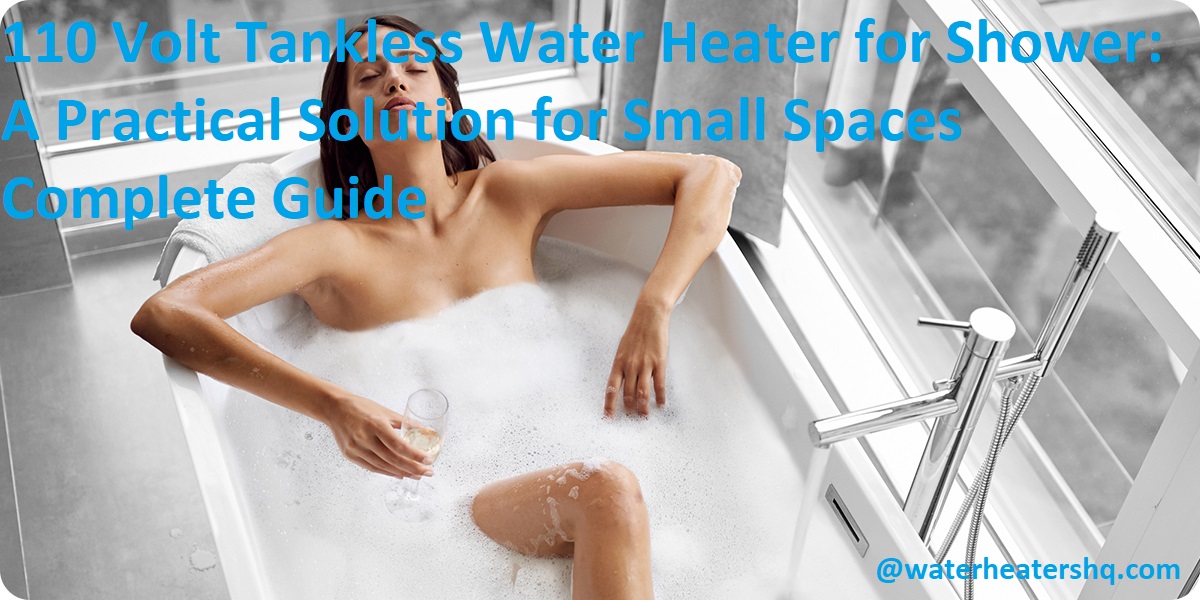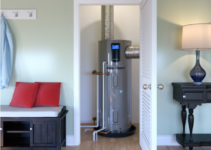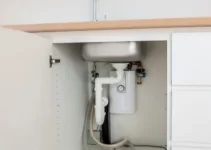Are you looking for a practical solution to provide hot water in your small space? Discover how a 110 Volt tankless water heater can provide a perfect hot shower experience with minimum power consumption!
In this comprehensive guide, you’ll find all the information you need to make an informed decision.
Today, many people are trying to save energy in various areas of their households. A great way to do this is by choosing an energy efficient appliance, like a tankless water heater. Tankless water heaters are becoming increasingly popular because they provide hot water on demand while conserving energy and saving space.
This article provides an overview of 110 volt tankless water heaters for shower use, describes their advantages and disadvantages, and compares different models available on the market today. It also explains how you can choose the best tankless water heater for your shower needs. So whether you’re looking for a cost-effective way to keep your showers hot or just want to conserve energy in your home, a 110 volt tankless water heater may be the perfect solution for you.
Explanation of the problem
Living in a small space can be challenging, particularly when it comes to finding solutions for those various “must-haves” that come with modern living. One of the most common issues is the problem of locating an appropriate and safe water heater for hot showers.
A 110 Volt tankless water heater for shower may be a practical solution for those living in small spaces who do not have access to a central hot water system. This guide provides an explanation of the problem, the advantages and disadvantages of using 110 Volt tankless water heaters, and an overview of what to look for when making your purchase.

Importance of a 110 Volt Tankless Water Heater for Shower
When you are living in small spaces, an on-demand tankless water heater offers a great solution to meet your hot water needs with minimal space taken. This type of heater draws water directly from its own inlet, warms it up and then sends it directly to the outlet point. Being powered by an electric current, these 110 voltage tankless water heaters can be installed nearly anywhere around the house and will not occupy much floor space.
Benefits of 110v tankless water heaters for shower include:
- Circulating hot water on demand with no waiting time
- Cost savings over traditional tanks due to reduced energy consumption
- Ability to easily adjust temperature based on preference
- Flexible placement since there are no tanks taking up much space
- Compact and lightweight design that can be quickly installed almost anywhere with minimal plumbing skills
- Variety of sizes and styles available depending on usage requirements
- Easy maintenance over time due to direct access to elements and simple operation system
Understanding Tankless Water Heaters
Tankless water heaters are a great energy-saving solution for small spaces or those that have limited access to plumbing. Tankless water heaters use heated coils to provide on-demand hot water, ensuring that users never have to wait for their shower to warm up. The tankless style is also much more efficient than conventional tank models because there is no need for frequent heating and cooling cycles.
In order to understand how a tankless water heater works, it’s important to know that there are two different types of systems available: electric and gas-fired.
When electricity is used as the power source, the device relies on an electric coil system instead of an actual storage tank. This coil system heats the incoming water supply as it passes through the unit, providing an immediate source of hot water when your shower or faucet is turned on. Gas systems can be either natural gas or liquid propane and they draw fuel from an external tank in order to generate enough heat for your home’s needs. Both types of units typically come with a digital screen or dial interface which allows you to adjust the temperature and flow rate settings as needed.
No matter what type you choose, make sure that your tankless unit is compatible with your space’s infrastructure (electricity, gas supply) and has sufficient GPM (gallons per minute) rating in order to achieve your desired hot water flow rate. It’s also important to remember that these small appliances require professional installation as well as regular maintenance in order to operate at optimal levels. It’s advised that you contact a professional service provider if you need further help understanding how this product works in order to find the best solution for your needs.
Definition of tankless water heater
A tankless water heater, also known as an “on-demand” water heater, is a type of water heating system that does not use a tank. The tankless heater heats the water only when it comes into contact with the heating element. This means that hot water is available on demand, resulting in significant energy savings compared to traditional models with tanks as there is no need to keep a tank of preheated water.
Tankless systems also take up much less space since they do not require an ample space for storing large tanks of hot water in order to heat the home. A 110 volt tankless water heater for shower offers an ideal solution for those who live in tight spaces yet still desire access to hot running water.
How tankless water heaters work
Tankless water heaters, also known as on-demand water heaters, provide hot water when it is needed without the need to store a large volume of water. They consist of a gas burner or electric element that heats the water directly rather than relying on a storage tank and are considered one of the most energy efficient solutions for homes with small spaces and limited hot water needs.
In order to understand how these systems work, it helps to understand the anatomy of an electric tank-style heater. A typical tank heater has an electric heating element located inside the tank along with thermostat control buttons which allow you to set your desired temperature and determine when the tank should heat up. When you turn on a hot water tap, cold water flows into the tank and is heated by the heating element before being sent through pipes back out into your home. With this type of system there is often an excessive amount of standby energy loss due to the standing hot water in your tank which can cause significant waste during periods of non-use.
Tankless heaters, on the other hand, bypass any kind of storage container altogether and instead send cold water directly from its source (usually a municipal or well) through pipes that pass over a powerful heating element or gas flame which instantly heats it up before sending it back out into your home for use at whatever temperature you’ve selected. This allows them to eliminate standby losses altogether while still delivering hot water whenever you need it without having to store or wait for any kind of thermal recovery time—making them an effective solution for smaller spaces!
Types of tankless water heaters
When shopping for a tankless water heater, it’s important to understand the difference between the various types available. Each type has unique benefits and drawbacks that should be considered before making a purchase. Below is an overview of the most common types of tankless water heaters to help you make an informed decision.
Electric Water Heaters: An electric tankless water heater uses resistance coils or heating elements to directly heat up the water passing through it, with no storage mandated for pre-heated hot water. Although these models require less space than traditional storage tank heaters, their limitations may include poorer flow rates at lower temperatures and not enough flexibility for larger households with a heavy demand for hot water.
Gas Water Heater: In contrast to electric models, gas-powered tankless water heaters use either propane gas or natural gas as a source of energy. They provide greater levels of power and flow rates than comparable electric models while avoiding any electrical power requirements, although they may be slightly bulkier in size due to venting requirements.
Hybrid Electric/Gas Water Heaters: These modern hybrid systems offer the best of both worlds by combining the capacity and efficiency of traditional storage tanks with the immediate responses provided by tankless designs They are cost-efficient even at low temperatures with regards to electricity consumption when used together with a special temperature regulation setup since gas will usually be used only when necessary during peak periods on very cold days when elevation in temperature is needed much more frequently than usual.
Installation of a 110 Volt Tankless Water Heater
Installing a 110-volt tankless water heater for shower is an attractive option for people who are limited on space and don’t have the capacity to install a 240-volt system. This type of installation requires fewer wires, and typically costs less than a 240-volt system.
Before starting the installation process, careful consideration should be given to the electrical requirements for your setup. An electrical permit may be required from your local permitting authority if the electric code necessitates it. All wiring should be done by an electrician in accordance with national electric code, local codes and applicable laws.
Once you’ve sourced all of your supplies, it’s time to begin with the installation process. Start first by installing a circuit breaker or disconnect switch on your distribution panel or subpanel that will be wired to the tankless water heater unit itself. The installation will vary depending on what circuit breakers and/or switches you have available. Refer to manufacturers’ instructions before proceeding with wiring.
Next, wire a building ground wire to the neutral terminal of either a 120/240 volt dual pole breaker or 120/240 volt single phase main disconnect switch that is connected to the tankless water heater unit itself, then connect all other wires from service entrance conduit as required in accordance with labeling of terminals by a licensed professional electrician per proper electrical codes and laws. Make sure not to exceed maximum amperage rating for circuit breaker(s) being used for specific application(s). When you have finished connecting all wires, double check all connections with an insulated multi meter tester before turning power on!
Preparation
Before installing the 110 volt tankless water heater for shower, it is important to check the size and specifications of your space. You also need to decide which type of model you need and if it meets your needs regarding output as well as safety. You may need to use additional materials or tools other than the installation instructions guide in order to complete the job correctly.
It is important to read all of the instructions that come with your heater carefully before beginning the installation process. The instructions will include steps, diagrams, and notes on special requirements or tools that may be needed, so make sure you understand them thoroughly before attempting to install your unit. Make sure all electrical outlets are in safe condition and meet any local codes that apply before continuing. Additionally, you should turn off any power sources in the area while working with electricity near water. Overall safety precautions should also be considered such as wearing protective Gear (gloves, safety glasses) and keeping a fire extinguisher handy in case of emergencies or mishaps.

Tools and materials required
Before you begin installing a 110-volt tankless water heater for shower, there are some tools and materials you need to pick up in addition to the water heater. These will include items such as manufacturer’s approved installation kit, PEX tubing for connecting the 110-volt tankless water heater with the faucet, screwdriver, rag or towel for cleaning work surfaces, PVC glue for securing any plastic joints in the pipe system, wall anchors and screws for mounting the unit to wall studs, level and measuring tape.
Be sure to read through all instructions provided by the manufacturer before beginning your installation process.
Maintenance of a 110 Volt Tankless Water Heater
Regular maintenance of a 110 volt tankless water heater is key to keeping your unit functioning properly, as well as operating at peak efficiency. It’s important to keep up with the recommended maintenance schedule for your brand and model of tankless water heater. In general, servicing a tankless water heater should take place every two or three years; however, certain models may have differences in frequencies needed for service. Furthermore, the frequency of maintenance may depend on the hardness of the water you experience in your area.
The following step-by-step guide will help you effectively maintain a 110 volt tankless water heater:
- Before performing any work on the system, be sure to turn off power to the unit at the breaker box and shut off all incoming water valves by turning them clockwise as far as they will go.
- Carefully inspect and clean various parts such as sensors and thermistors that can easily become clogged with sediments or contaminants from household minerals or other particles picked up from public flushing systems when in use for extended periods such as during winter months when local temperatures drop into very cold spell conditions (these parts should de inspected in detail at least twice annually).
- Check all valves and filters for proper fit and proper operation making sure they are not blocked by minerals or sediments released from inside the tank during use such as limestone or iron oxide deposits collected over time; if found clogged replace all filters immediately including any preheat tanks which must also be vented regularly only into areas not used by humans such s basement crawl spaces).
- Inspect exterior components for any signs of rusting which may indicate failing insulation due to lack of preventative maintenance upkeeps causing air pockets trapped insides walls weakened support structures resulting in eventual failure leading to further more damaging issues beyond regular servicing needs; severe rust damage can degrade thermal efficiency and increase noise level performance general associated with hot exiting steam releases venting outdoors wreaking havoc with sound levels inside otherwise quite areas located near these exterior sources (be sure all exterior body panels remain securely fastened at all times).
By adhering to this recommended guide for regular servicing needs you will help prolong lifetime performance reducing common breakdown occurrences resulting in cost savings enjoyed by most ethical home owners looking forward maintain their properties operating efficiently over time within expected limits understood by experienced contract personnel familiar work need required managing 110 volt Tankless Water Heater outlets universally recognized forms today’s modern indoor plumbing fixtures available cost effective installers guaranteeing reliability long term results backed quality assurances given written consumer agreements accepted professional plumbers everywhere always!
Importance of maintenance
Proper maintenance of 110 volt tankless water heaters is important to ensure that you can get the most out of them and that they last a long time. There are several steps that need to be taken when it comes to maintaining a tankless water heater, such as cleaning the filter, flushing out deposits, and descaling the components on a regular basis. All of these steps are important to help maintain peak performance and efficiency.
Cleaning the filter on a regular basis is one of the most important maintenance tasks for 110 volt tankless water heaters. This will help ensure that any dirt or silt that accumulates in your heater is removed, helping maximize its efficiency and performance. Additionally, it’s also important to flush out any deposits or scale build-up in order to keep your heater running as efficiently as possible. Descaling is also recommended in order to remove any built-up limescale from inside your heater; this will help extend its lifespan and keep it working properly for longer.
Maintenance checklist
It is important to take care of your 110 volt tankless water heater so it can last and provide you with many years of satisfying use. A few minutes each month can mean the difference between a healthy water heater and repair or replacement down the line. There are some basic maintenance steps that need to be done on a regular basis for proper care of your tankless water heater. This maintenance checklist will provide guidance for troubleshooting common problems associated with your 110 volt tankless water heater for shower use:
- Check for visible signs of damage: Be sure to inspect the entire unit for evidence of wear and tear that may indicate an underlying problem. Look closely around pipes, wiring, inlets, outlets, filters, etc., for signs of corrosion or physical damage.
- Test pressure relief valve: Make sure the pressure relief valve is operating properly by pouring a cup of cold water over the top. If there is any excessive dripping or leaking when opening or closing the valve this could be a sign that it needs to be removed and replaced.
- Remove sediment buildup: Over time sediment can build up inside the unit causing it to become less efficient in providing hot water. To ensure full heating power, remove all sediment using an appropriate cleaning agent and follow manufacturers guidelines closely when cleaning this tankless water heater component.
- Check internal components regularly: Make sure necessary elements such as vent fans, coils and circuit boards are free from dust accumulation which will reduce efficiency in heating cycles and eventually lead to overheating issues or even complete failure if left unchecked. it is also important to inspect hose connections often as loose connections could lead to decreased efficiency or possible leaks that would require further inspection from a professional technician.

Conclusion
In conclusion, the 110 volt tankless water heater for shower can offer a convenient and practical solution for small homes or apartments. By eliminating the need for a large tank and providing instant hot water, these units provide increased space-saving benefits along with longer life expectancy.
Having hot water available on demand means that one can enjoy a better showering experience without the worry of tank depletion or cold temperatures. Additionally, these units do not require costly venting materials, making them easier and cheaper to install than tank-style heaters.
While there are several drawbacks to consider prior to purchase such as limited flow rates and higher installation costs, a 110 volt tankless water heater can be an attractive option for those seeking an efficient way to save space while still enjoying an enjoyable showering experience.
FAQ’S
What size tankless water heater do I need for a small house?
The size of a tankless water heater needed for a small house depends on the household’s hot water usage patterns, but a typical recommendation is for a unit with a flow rate of 2-3 GPM.
What size tankless water heater is needed for a shower?
The size of a tankless water heater needed for a shower depends on the desired flow rate and temperature rise. A typical recommendation for a single shower is a unit with a flow rate of 2-2.5 GPM.
Can a tankless water heater be used for a shower?
Yes, a tankless water heater can be used for a shower, as long as it is properly sized to meet the household’s hot water demands.
Do tankless water heaters run on 110?
No, most tankless water heaters require a higher voltage, typically 240 volts, to operate.
What is the disadvantage of a tankless water heater?
One disadvantage of a tankless water heater is that it may require a higher upfront cost compared to a traditional storage tank water heater.
What happens if a tankless water heater is too small?
If a tankless water heater is too small, it may not be able to meet the household’s hot water demands, resulting in inadequate hot water flow and temperature fluctuations.
What size water heater do I need for 1 person?
The size of a water heater needed for one person depends on the household’s hot water usage patterns, but a typical recommendation is for a unit with a capacity of 20-30 gallons.
How much wall space do you need for a tankless water heater?
The amount of wall space needed for a tankless water heater varies depending on the unit’s size and installation requirements. It’s best to consult the manufacturer’s specifications for the specific unit you are considering.
Which is better, tankless or tank?
Tankless water heaters are generally more energy-efficient and have a longer lifespan than traditional storage tank water heaters. However, they may require a higher upfront cost and have a limited hot water output compared to tank water heaters. The choice depends on your specific needs and preferences.
Do tankless water heaters take up less space?
Yes, tankless water heaters are typically more compact than traditional storage tank water heaters and can be mounted on a wall to save space.
See Also:
- Best 80 gallon electric water heater
- Best 110 volt tankless water heater for shower
- Best electric tankless water heater
- Best electric tankless water heater for rv
- Best electric tankless water heater for whole house


